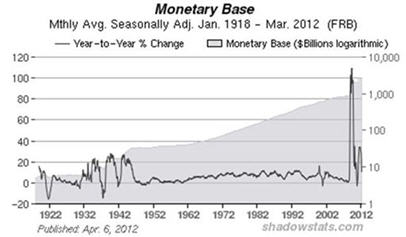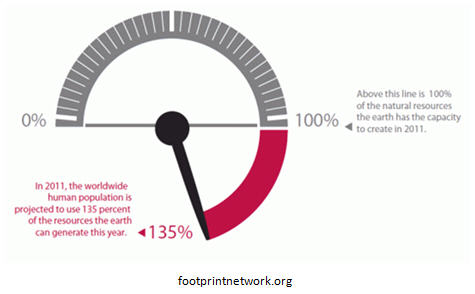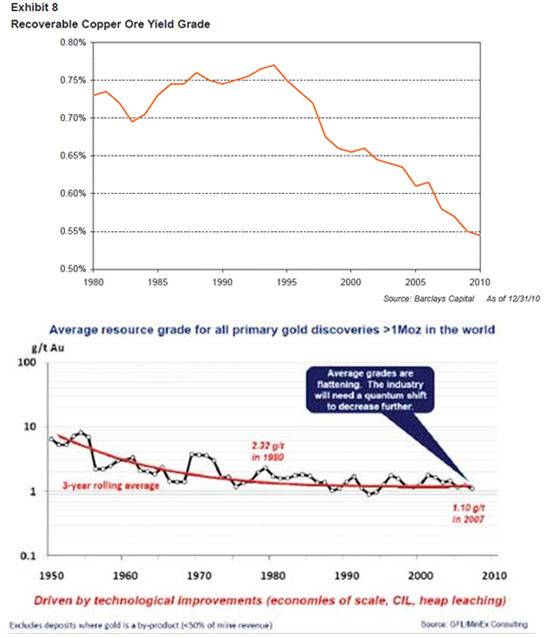An argument for a contrarian investment
While it might not look like it now, the most investable trend over the next 20 years is going to be in the resource sector, the renewable and non-renewable resources, the minerals, ores, fossil fuels and biomass a wealthier and growing global population is increasingly demanding from finite supplies and already strained production capabilities.
Renewable and Non-renewable Resources
We have crossed a critical threshold. The demand we are now placing on our planets resources appears to have begun to outpace the rate at which they can be supplied.
The gap between human demand on our planet’s renewable resources and the supply of those resources is known as ecological overshoot. To better understand the concept think of your bank account – in it you have $5000.00 paying monthly interest. Month after month you take the interest plus $100. That $100 is your financial, or for our purposes, your ecological overshoot and its withdrawal is obviously unsustainable.
The human enterprise now consumes nearly 60 billion metric tons of the world’s four key resources – minerals, ores, fossil fuels and biomass (plant materials) – per year.
Developed countries citizens consume an average of 16 tons of those four key resources per capita (ranging up to 40 or more tons per person in some developed countries).
According to a report from the U.N., by 2050, humanity could devour an estimated 140 billion tons of minerals, ores, fossil fuels and biomass per year.
Total global resource use soared from six billion tonnes in 1900 (1.6 billion people) to 49 billion tonnes in 2000 (just over 6 billion people) and is now running at close to 60 billion tonnes (just over 7 billion people).
Demand/Consumption
Two factors are involved in increasing consumption. One is the growth in population:
2011 7 billion
2020 7.6 billion
2027 8 billion
2030 8.2 billion
2040 8.8 billion
2046 9 billion
2050 9.2 billion
The second factor is the growth in wealth in the major developing countries – China, India, Africa* and Indonesia have enormous numbers of people who are already middle class and hundreds of millions still to become middle class.
*Africans, on a per capita basis, are richer than Indians and a full dozen African states have higher gross national income per capita than China.
Today Africa has 14% of the world’s population and by 2050 one in every four people on the planet will be African. The rapidly emerging African middle class could today number almost 300 million people – that’s out of a total population of one billion.
The Organization for Economic Co-operation and Development says the global middle class numbers 1.8 billon, or 28% of the world’s population.
According to the UN report “RESILIENT PEOPLE RESILIENT PLANET A Future Worth Choosing” the number of middle-class consumers will increase by three billion people over the next 20 years.
The president of the Center for Global Development, Nancy Birdsall, calculates that India has no middle class. The McKinsey Global Institute projects that India’s middle class of 50 million – less than 5% of the country’s population – will explode to 583 million by 2030.
McKinsey Global puts China’s middle class at 43% of its population today, on its way to 76% in 2025.
Economic studies suggest that industrial metals and minerals consumption depends on the stage of development, the stages are normally divided in four, and are said to be dominated by 1) infrastructure development, defined by high use of cement and construction materials; 2) light manufacture, defined by high use of copper; 3) heavy manufacture, defined by high use of aluminum and steel; and 4) Consumer goods, defined by high use of aluminum, energy minerals and specialty steels (Source: USGS).
The stages are expected to take about 20 years each and begin at 5 year intervals, lasting for a total of 30 – 40 years, depending on political and macroeconomic conditions. China for instance, appears to have entered the heavy manufacture stage based on steel consumption, while India may be well into the light manufacturing stage.” Luisa Moreno Investingthesis.com
Of course many other factors are at play and will, going forward, contribute to a “perfect storm” in the commodity markets.
Inflation
Because central banks can increase the supply of money virtually at will, and do so, the value of all existing money decreases.
The amount of goods and services remains the same, but now the amount of money chasing them has increased, this increased competition – more money (inflation) for the same amount of goods and services – causes prices to rise.
Governments and Central Banks want slowly rising prices. They pour money into the market to encourage growth so prices increase rather than decrease. Price decreases, or deflation (less money growth), slows economic activity – if people think prices are going to be lower next week they will not buy today, they will wait, this leads to a contraction in economic activity, something all governments fear.
Nations in Europe, and the U.S., will inflate (print more of) their currencies rather than cutting back spending or raising taxes. In a global race to worthless Asian economies will also have to print massive amounts of their currencies so they stay weaker then the US dollar. Asian exports have to be cheap for American consumers and American exports have to be more expensive than locally produced goods.
Many have called for very high levels of inflation possibly leading to hyperinflation. Their reasoning is that over printing of the US dollar will cause the dollar to weaken and inflation to set in – more money chasing the same amount, or less, of goods causes prices to rise. A rise in gold, silver and commodities prices in would be the result.
 The precious metals and commodities have gone up, substantially – prices reacted to the increase in the monetary base and the corresponding increase in the velocity of money caused by financial innovations such as mortgage-backed securities (MBS), collateralized debt obligations (CDO), derivatives and credit default swaps etc.
The precious metals and commodities have gone up, substantially – prices reacted to the increase in the monetary base and the corresponding increase in the velocity of money caused by financial innovations such as mortgage-backed securities (MBS), collateralized debt obligations (CDO), derivatives and credit default swaps etc.
The monetary base was expanding and there was an orgy of money spending fueling expectations of inflation.
As soon as the QE program, part’s 1 & 2, ended in June of 2011 the markets had to get by on a lot less money and liquidity. Austerity has temporarily replaced prolific spending – the monetary base is not expanding, money is not circulating and this is fueling deflationary fears.
Today the dollar is strong because the EU, and the world, have an acute shortage of dollars for the necessary bailouts and needed liquidity. A rising dollar is noninflationary so the rising dollar produces lower commodity prices.
It’s this author’s belief the US, and the world, will return to Quantitative Easing (QE) and will flood the world with liquidity. A falling weaker dollar pushes up the price of commodities.
Single minded money printing has to be the next stage. Politicians, governments and central banks will abandon the restraints they have been operating under and do whatever they think it will take to pacify voters, save their re-election chances, “right” their economies and salvage the fiat monetary system. Tax cuts, more and bigger deficits, continued low interest rates into the forseeable future and aggressive asset purchase programs, steroidal quantitative easing, are all going to achieve previously unimaginable levels.
The monetary base will explode, and if the money velocity chart reverses – if small businesses and consumers actually get their hands on some of this money – precious metals and commodities prices will soar.
Supply
Supply shortages always lead to high enough metal prices for further increases in production, thus supply will eventually exceed demand and prices will drop…right? Well maybe, maybe not. Margins (not price) motivates investment and if the cost of metal production is increasing margins might not be sustainable.
Lets state the obvious:
- For over the last ten years supply has struggled to keep pace with demand
- Metal supply is finite and subject to compounding demand from developing nations
- Metal production is highly cyclical, with intermittent peaks and troughs which are closely linked to economic cycles – declining production has historically been driven by falling demand and prices, not by scarcity
- Rates of production and amounts of reserves continually change in response to movements in markets and technological advances
- Most mineral resources will not be exhausted in the near future
- If energy was cheap and unlimited then recoverable resources would be unlimited
But
- Discovery and development is increasingly becoming more challenging and expensive
- Average ore grades are in decline for most minerals, yet production has increased dramatically
- Our most important metals are suffering from declining ore quality and rising extraction (ore is a different and inferior chemical or structural composition) costs
- Our prosperity has always been based on the fact that producing resources yielded more resources than it cost. However the cost of *energy is climbing, the amount used is climbing but the returns from energy expended is declining. Eventually the quantity of resources used in the extraction process will be 100% of what is produced
- Most older existing mines, the foundation of our supply, have increasing costs with production rates stagnating or even declining
- The rate of discovery is not keeping pace with the rate of depletion, let alone being higher
*Energy can be thought of as a proxy for labor, materials, energy and externalities – environmental, community impact etc.
The metal content of copper ore has been falling since the mid 1990s. A miner now has to dig up an extra 50 percent of ore to get the same amount of copper. As grade drops the amount of rock that must be moved and processed per tonne of produced copper rises dramatically – all the while using more energy that costs several times more than it use to. With the lower grades of ores now being mined energy becomes more and more of a factor when considering economics.
The average grade of gold deposits has been dropping as well.
“We took the nice, simple, easy stuff first from Australia, we took it from the U.S., we went to South America. Now we have to go to the more remote places.” Glencore CEO, Ivan Glasenberg in the Financial Times describing why his firm operates in the Congo and Zambia
We are experiencing a paradigm shift. If nothing else, right now at this point in history, we all have to realize that the mining industry is exiting “easy & cheap” and is starting the upward slope of chronic lower supply, permanently higher prices and higher risk.
Increasingly we will see falling average grades being mined, mines becoming deeper, more remote and come with increased political risk. Extraction of metals from the mined ore will is becoming more complex and expensive.
Resource Nationalism
Country Risk – Where the political and economic stability of the host country is questionable, and abrupt changes in the business environment could adversely affect profits or the value of the company’s assets.
Resource nationalism – The tendency of people and governments to assert control, for strategic and economic reasons, over natural resources located on their territory.
Every country needs to secure supplies of needed commodities at competitive prices yet supply is increasingly constrained and demand is growing. Barring a total global economic collapse or a dramatic reduction in the world’s human population it doesn’t seem to this author demand is going to collapse anytime soon.
Access to raw materials at competitive prices has become essential to the functioning of all industrialized economies. As we move forward developing and developed countries will, with their:
- Massive population booms
- Infrastructure build out and urbanization plans
- Modernization programs for existing, tired and worn out infrastructure
Continue to place extraordinary demands on our ability to access and distribute the planets natural resources.
Threats to access and distribution of these commodities could include:
- Political instability of supplier countries
- The manipulation of supplies
- The competition over supplies
- Attacks on supply infrastructure
- Accidents and natural disasters
- Climate change
Accessing a sustainable, and secure, supply of raw materials is going to become the number one priority for all countries. Increasingly we are going to see countries ensuring their own industries have first rights of access to internally produced commodities and they will look for such privileged access from other countries.
Numerous countries are taking steps to safeguard their own supply by:
- Stopping or slowing the export of natural resources
- Shutting down traditional supply markets
- Buying companies for their deposits
- Project finance tied to off take agreements
“Resource nationalism is taking other forms as well, including greater controls on foreign participation, mandated beneficiation, use it or lose it demands and mandated government participation.” Ernst & Young Global Mining & Metals Leader Mike Elliott
The PricewaterhouseCoopers Mine 2011 survey highlights what governments across the globe are looking at in regards to the world’s top 40 miners:
- Achieved net profits of $110b last year
- Halved their debt
- Built cash reserves of $105bn
- Announced capital programs of $300b for 2011
Today many governments are looking at ways to get more money from miners as companies report record profits – the higher the returns and the higher the profits, the greedier governments become. As commodity prices rise governments try to boost their share of the proceeds from their countries energy and mining sectors.
Miners are an easy target as mining is a long term investment and one that is especially capital intensive – mines are also immobile, so miners are at the mercy of the countries in which they operate. Outright seizure of assets happens using the twin excuses of historical injustice and environmental/contractual misdeeds. There is no compensation offered and no recourse.
All of this means increasingly scarce, and accessible resources, are going to become much harder to find and develop – meaning companies with projects in politically stable environments are that much more valuable.
Skills and Labor Shortage
A combination of mass retirements and increasing natural resource demand from emerging economies has created a crisis in the resource extraction sector – one which is definitely not on investor’s radar screens.
Currently there is a “massive talent gap” that is going to get worse because the global mining industry is experiencing the biggest wave of workforce retirements in 70 years – the oldest baby boomers turned 65 years old in 2011.
The Mining Industry Human Resources Council (MIHRC) has recently said that about 40% of the resource extraction industry’s workforce is at least 50 years old and one third of them are expected to retire by 2022.
The organization also forecasts that the Canadian mining industry will face a shortage of 140,000 workers by 2021 – this number of workers being needed just to maintain current levels of production.
The Petroleum Human Resources Council of Canada warned a severe oil patch labor shortage is looming and that the “patch” will need to hire 24,000 new employees by 2014.
Increased resource demand is driving demand for skilled workers. A shortage of skilled workers was the second biggest business risk for mining in 2011 (as it was in 2010) and is forecast to be the number two risk (resource nationalism/country risk is the number one risk) for miners again in 2012. In the coming years a lack of skilled workers is going to be the major cause for concern in the resource extraction industry.
“Government or industry reports in the past few years in Australia, the U.S. and South Africa all highlight growing skills shortages in the mining industry.” Recent HSBC commodities report
The skills shortages are global, shortages are happening in South Africa, Australia, Canada and South America. Costs are increasing, projects are being deferred or perhaps even cancelled outright due to the inability to staff operations – tighter labor markets also provide unions with greater bargaining powers when dealing with companies over wage settlements and other disputes.
“Given the ageing profile of the current workforce and a lack of engineers and geologists with enough experience, the labour resourcing requirements for new mining projects at various stages of development across the globe are simply not going to be met. Production targets and project deadlines are inevitably going to slip. The time taken to train a mining professional can be up to five years, but it is the candidate with around ten years experience who is in particularly short supply. A failure by the mining industry to recruit and train during the tough times in the 1990s, when the price of metals plummeted, has led to particular shortages of mid-career professionals.” Mining Global Employment Review 2011, Faststream Recruitment
Analysts say attracting and retaining increasingly scarce skills will:
- Accelerate cost increases
- Squeeze profit margins
- Threaten the viability of some marginal projects
Conclusion – Junior’s, An Argument for a Contrarian Investment
Our reality – we’re living on a relatively small planet with a finite amount of reserves and a growing human population.
The world’s major miners are making immense profits but they are having an extremely difficult time replacing reserves let alone growing them. Mining is the story of depleting assets, that asset must be constantly replenished, miners that want to stay in business must replace every pound, oz and gram taken out of the ground.
Juniors, not majors, own the worlds future mines and juniors are the ones most adept at finding these future mines – majors do not make discoveries, juniors do, that’s their function in the resource food chain. Junior resource companies already own, and find more of, what the world’s larger mining companies need to replace reserves and grow their asset base.
Junior resource companies – the same ones who today are so oversold and undervalued – are the present owners of the world’s future commodities supply and, most important for investors seeking outsized returns, they act like leveraged exposure (with price gains many times that of the underlying commodity) to the specific commodity(s) investors want exposure to.
Are there a few junior resource companies, with exceptional management teams operating in politically safe jurisdictions, on your radar screen?
rick@aheadoftheherd.com
If you’re interested in learning more about the junior resource and bio-med sectors please come and visit us at www.aheadoftheherd.com
Site membership is free. No credit card or personal information is asked for.
***
Richards articles have been published on more than 400 websites including:
Wall Street Journal, SafeHaven, Market Oracle, USAToday, National Post, Stockhouse, Lewrockwell, Pinnacledigest, Uranium Miner, Beforeitsnews, SeekingAlpha, MontrealGazette, Casey Research, 24hgold, Vancouver Sun, CBSnews, SilverBearCafe, Infomine, Huffington Post, Mineweb, 321Gold, Kitco, Gold-Eagle, The Gold/Energy Reports, Calgary Herald, Resource Investor, Mining.com, Forbes, FNArena, Uraniumseek, Financial Sense, Goldseek, Dallasnews, Vantagewire, Resourceclips and the Association of Mining Analysts.***
Legal Notice / Disclaimer
This document is not and should not be construed as an offer to sell or the solicitation of an offer to purchase or subscribe for any investment.
Richard Mills has based this document on information obtained from sources he believes to be reliable but which has not been independently verified; Richard Mills makes no guarantee, representation or warranty and accepts no responsibility or liability as to its accuracy or completeness. Expressions of opinion are those of Richard Mills only and are subject to change without notice. Richard Mills assumes no warranty, liability or guarantee for the current relevance, correctness or completeness of any information provided within this Report and will not be held liable for the consequence of reliance upon any opinion or statement contained herein or any omission.
Furthermore, I, Richard Mills, assume no liability for any direct or indirect loss or damage or, in particular, for lost profit, which you may incur as a result of the use and existence of the information provided within this Report.
More News
{{ commodity.name }}
{{ post.title }}
{{ post.date }}





Comments